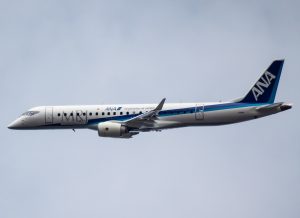After years of twists and turns, Japan’s biggest defense company, Mitsubishi Heavy Industries (MHI), has officially announced it will scrap development of what would have been the nation’s first homegrown passenger jet aircraft.
MHI said on February 7 it has decided to end the development of the SpaceJet, formerly known as the Mitsubishi Regional Jet, shattering a long-cherished dream of both Japan’s public and private sectors to debut the nation’s first advanced jet airliner.
“We have received high expectations and support from many people, but it is very regrettable that we have decided to discontinue development,” Izumisawa Seiji, the president of MHI, said at a press conference in Tokyo on the same day.
Izumisawa said its jet project was abandoned because it is no longer expected to be profitable. He specifically pointed to a lack of understanding of the advanced type certificate process for commercial aircraft and a shortage of resources to continue long-term development as major points for reflection.
The company started its regional jet project in 2008. Initially, the development began as a 90-seat class aircraft. It was a major national project aimed at fostering the Japanese aircraft industry under the leadership of a private company. The Ministry of Economy, Trade, and Industry offered 50 billion yen ($381 million) in a public-private project to develop Japanese aircraft manufacturing.
Notably, the jet was to be the first domestic passenger aircraft developed in Japan since the YS-11, a turboprop made by Nihon Aircraft Manufacturing that flew for the first time in 1962 and was discontinued in 1974. Tojo Teruo, one of the Mitsubishi Zero fighter’s original engineers, served as the development leader of the YS-11. He was the second son of Tojo Hideki, the Japanese wartime prime minister who was convicted of war crimes and hanged.
In the late 1980s, Japanese automobile manufacturer Honda Motor Company started its HondaJet project. Honda had little expertise in the aerospace industry at the time, but it successfully started delivering the eight-seat aircraft in 2015 – after 30 years of R&D.
The development of the HondaJet was carried out in the United States and the Honda Aircraft Company, a subsidiary of Honda, managed to receive a type certification from the U.S. Federal Aviation Administration (FAA) in December 2015. MHI could not so easily achieve that feat.
A type certificate is required for commercial aircraft operation. Izumisawa, the MHI president, said that if the work to obtain type certification continued, “it will take several years at 100 billion yen per year.”
MHI was originally scheduled to deliver its planes to All Nippon Airways in 2013. However, due to a series of problems such as lack of technical capabilities and the COVID-19 nightmare, the development deadline was postponed six times. In the meantime, the initial development cost of 150 billion yen ballooned to 1 trillion yen.
In the fall of 2020, development of the SpaceJet was effectively frozen. Even after that, the project continued to acquire the type certification required for commercial operations, but in March 2022, the company scaled back operations by closing its test flight base in Washington state in the United States.
Called Meiko in Japanese, Nagoya Aerospace Systems Works in Aichi prefecture has been the home of the SpaceJet. It has also been the traditional core base for MHI’s fighter jet development and manufacture, including wartime Zero fighters.
Meiko’s plan to develop a domestic passenger aircraft, which had been a long-cherished wish for Japanese craftsmanship, has now met a serious setback. The SpaceJet, which requires 950,000 parts, was a hopeful star for local small and medium-sized enterprises aiming to enter the aircraft field, so the impact of the cancellation will be immeasurable.
That said, MHI is now aiming to develop the nation’s next-generation fighter for deployment in 2035 together with the United Kingdom and Italy at Meiko. The company said it will make use of the knowledge gained in the development of domestic jet aircraft.































